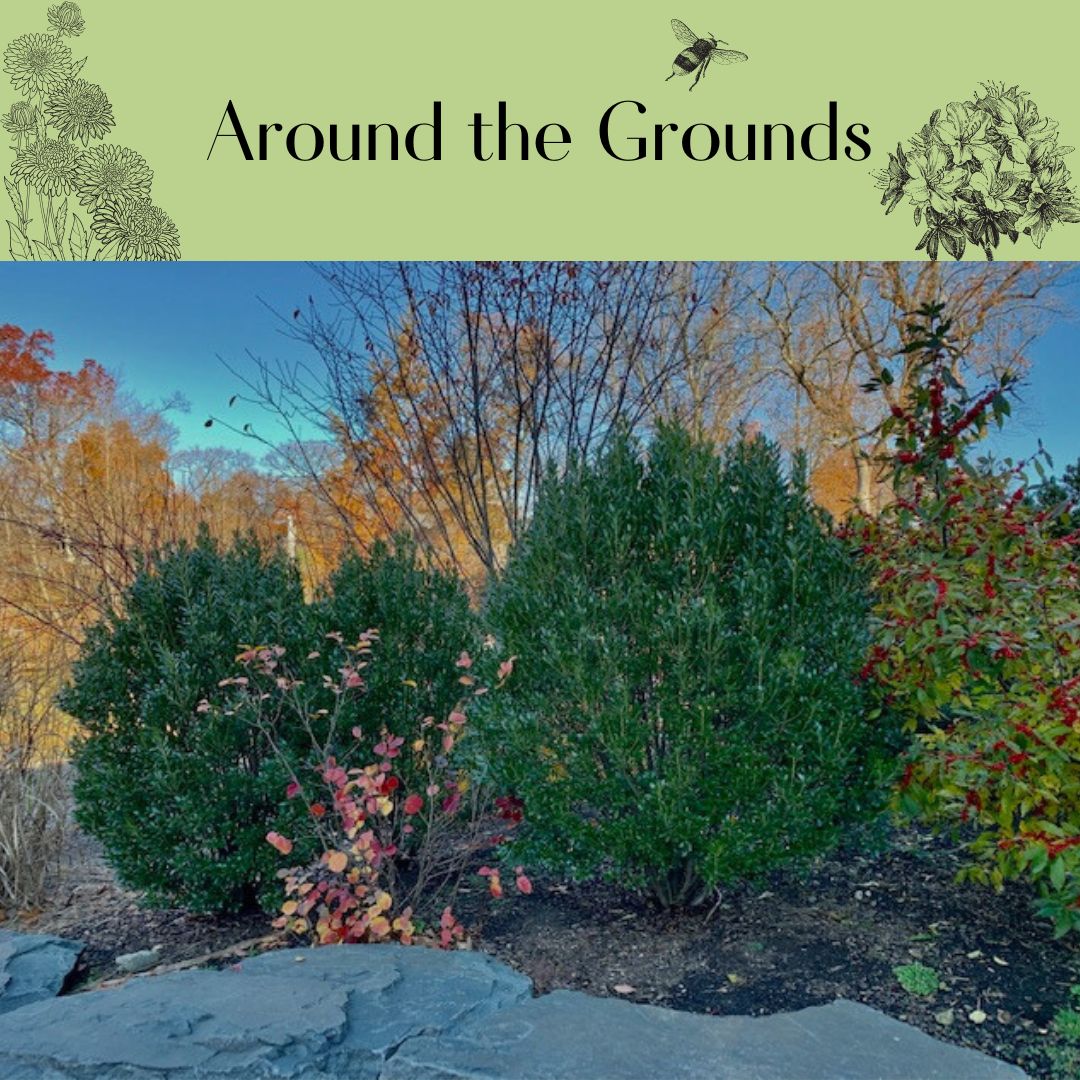Recently in Around the Grounds, we featured native shrubs that add splashes of color to the winter landscape. (Read our Winterberry and Red Osier Dogwood posts here.) While brilliant berries and colorful bark are important for winter interest, evergreen shrubs are the backbone of the garden, providing structure throughout the year. And, as we remind ourselves, green is a color, too!
Unfortunately, our suburban landscapes tend to use a very limited repertoire of evergreen plants. We think there are better and more interesting choices than boxwood and taxus for residential foundation plantings. Take a look at some of the evergreens we’ve used at the Nature Center:
One of our favorites is the native Inkberry (Ilex glabra). Inkberry resembles boxwood, with similar dark green, shiny leaves. And, like boxwood, it can be pruned into a hedge, or a sphere, or any shape Edward Scissorhands might fancy. We prefer to let it take a natural, rounded shape with dense branches as hiding places for songbirds.
Unlike boxwood, Inkberry is adapted to our climate because it is native here. Boxwood originated in southern Europe, northern Africa, and western Asia; all climates very different from ours. Gardeners here are advised to wrap boxwood with burlap in winter to protect it from cold, wind, and salt – not a great look for “winter interest.”
Inkberry is not only cold-tolerant, even to temps below zero, but it enjoys our acidic soil and doesn’t mind sitting in water after heavy rainfalls. It is deer-resistant and salt-tolerant. It does prefer full sun, but can handle some shade. The straight species will get 6 to 8 feet tall, but it can be sheared and shorter cultivars are available.
We’re not sure why so many suburban dwellers like plants pruned into ball shapes, but we do know a native evergreen that will take that shape without any help! Growers have developed cultivars of our native Arborvitae that grow naturally into a ball shape without pruning.
Arborvitae (Thuja occidentalis), also known as Eastern or Northern White Cedar, is very familiar as a tree; often used as a hedge or screen. It is native to our region and has wildlife value as a nesting site and seed supply for birds. Be advised that it is also famously attractive to deer. Some sellers of Globe Arborvitae claim the shrub is more deer-resistant than the tree, but we planted it close to a busy patio just in case. There are numerous cultivars of Globe Arborvitae available, with varying maximum sizes and slight color variations. Because we always prefer native plants, we would choose this little shrub over either boxwood or taxus – and we don’t have to prune it!
Another delightful evergreen shrub developed from a native tree is Pinus strobus ‘Soft Touch’ or Dwarf Eastern White Pine. ‘Soft Touch’ makes a great foundation plant. It is slow-growing, eventually taking a flattened shape no more than 2 feet tall, and wider than it is tall. It stays a lovely bright green all winter long. Its needles really are soft to the touch, and it’s hard to resist giving it a pat every now and then.
At the entrance to the Nature Center, we use another dwarf evergreen as a container plant. Dwarf Alberta Spruce (Picea glauca ‘Conica’) also was developed from a very large native tree, the White Spruce. This dwarf variety is very slow-growing and maintains its classic Christmas tree shape without pruning. It can live for years in containers, but should eventually be given some space in the landscape. It can become a 10-13 foot tree in time, so we will have to turn ours loose on the grounds in a few more years.
This blog is authored weekly by Cathy Ludden, conservationist and native plant educator; and Board Member, Greenburgh Nature Center. Follow Cathy on Instagram for more photos and gardening tips @cathyludden.

